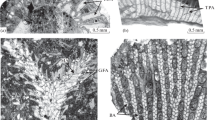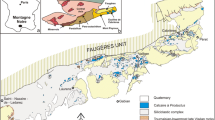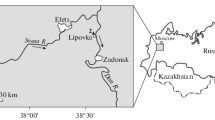Abstract
Based on the study of the growth habits and the relief of the colony surface in bryozoans of the class Stenolaemata from the Lower (Latorp horizon) and Middle (Volchov and Kunda horizons) Ordovician of the Leningrad Region, these bryozoans are shown to develop from the simple, unilaminate colonies (B βI ) to the massive colonies with a nodular surface and smooth columnar colonies (B αII ), which subsequently evolved into the columnar-spiral (B βII ) and more complex erect branching and fenestrate constructions (B γII ), and subsequently into the branching, articulate colonies (B αIII ). The apertures of autozooecia and the character of their arrangement on the colony surface changed correlatively from the circular (B βI ) to polygonal and roundedpolygonal, randomly arranged apertures, and subsequently to the oval apertures (B αIII ) arranged in strictly regular longitudinal or longitudinal-diagonal rows or in a quincuncial pattern. Thus, the development of growth habits in the bryozoans under consideration has a progressive character. It is expressed in the progressive increase in the complexity of growth habits of colonies and in the more regular arrangement of apertures and other structures on the colony surface. The directionality of morphological changes in the growth habits of colonies of Ordovician bryozoans was apparently closely associated with the development of more complex environmental interactions of these bryozoans, especially with water currents supplying food particles. It is suggested that the high competitive ability of bryozoans of the class Stenolaemata at early stages of its development in the basin of Baltoscandia was apparently due to the better use of food resources.
Similar content being viewed by others
References
R. L. Anstey, “Zooid Orientation Structures and Water Patterns in Paleozoic Bryozoan,” Lethaia 14(4), 287–302 (1981).
R. L. Anstey, “Colony Patterning and Functional Morphology of Water Flow in Paleozoic Stenolaemate Bryozoa,” in Bryozoa: Present and Past (West. Wash. Univ., Wash. (D.C.), 1987), pp. 1–8.
G. G. Astrova, Morphology, Developmental History, and Taxonomic System of Ordovician and Silurian Bryozoans: Proceedings of the Paleontological Institute of the Academy of Sciences of the USSR, Vol. 106 (Nauka, Moscow, 1965) [in Russian].
W. C. Banta, F. M. McKinney, and R. L. Zimmer, “Bryozoa Monticules: Excurrent Water Outlets?,” Science 184 (4153), 783–784 (1974).
R. S. Boardman, A. H. Cheetham, and P. L. Cook, “Introduction to the Bryozoa,” in Treatise on Invertebrate Paleontology: Part G (Geol. Soc. Am. and Univ. Kans. Press, Laurence, 1983), Vol. 1, pp. 3–48.
K. Brood, “Bryozoan Ecology in the Silurian of Gotland,” Spec. Pap. Paleontol., No. 32, 211–224 (1984).
R. Cowen and J. Rider, “Functional Analysis of Fenestellid Bryozoan Colonies,” Lethaia 5(2), 147–164 (1972).
R. J. Cuffey, “Bryozoan Contributions to Reefs and Bioherms through Geologic Time,” Am. Assoc. Petrol. Geol. Stud. Geol., No. 4, 181–194 (1977).
A. V. Dronov, Distinctive Features of Nontropical Carbonates Exemplified by the Lower-Middle Ordovician Deposits. Lithology and Oil and Gas Resources of Carbonate Deposits. Proceedings of the Second All-Russia Lithological Conference and the Eighth All-Russia Symposium on Fossil Corals and Reefs (Geoprint, Syktyvkar, 2001a) [in Russian].
A. V. Dronov, Cold-Water Carbonate of Ramps: Sequential Stratigraphy and Sedimentology. Proceedings of the Second All-Russia Lithological Conference and the Eighth All-Russia Symposium on Fossil Corals and Reefs (Geoprint, Syktyvkar, 2001b) [in Russian].
W. Dybowski, “Die Chaetetiden der Ostbaltischen Silurformation,” Verchandl. Russ. Kaiserl. Mineral. Ges. St. Petersburgs 2(14), 1–134 (1877).
E. Eichwald, Zoologia specialis quam expositis animalibus tum vivis fom fossilibus potissimum Russiae in universum et Poloniae in specie, Vol. 1: Bryozoa (Typis Josephi Zawadzki, Vilnae, 1829), pp. 179–201.
M. A. Gibson, “Paleoecology and Biostratigraphic Implications of a Fenestrate Bryozoan Buildup in Noncarbonate Environment, Pennington Formation (Late Mississippian), Alabama,” Compass Sigma Gamma Epsilon 64(1), 23–29 (1986).
R. V. Gorjunova, Morphology, Taxonomy, and Phylogeny of Bryozoans (Order Rhabdomesida): Proceedings of the Paleontological Institute of the Academy of Sciences of the USSR, Vol. 208 (Nauka, Moscow, 1985) [in Russian].
R. V. Gorjunova, “Evolution of Colonial Integration in Paleozoic Bryozoans,” in Morphogenesis and Evolution of Colonial Structures in Bryozoans and Coelenterata (Nauka, Moscow, 1987), pp. 45–69 [in Russian].
R. V. Gorjunova, Morphology and Taxonomic System of Paleozoic Bryozoans: Proceedings of the Paleontological Institute of the Russian Academy of Sciences, Vol. 251 (Nauka, Moscow, 1992) [in Russian].
R. V. Gorjunova, Phylogeny of Paleozoic Bryozoans: Proceedings of the Paleontological Institute of the Russian Academy of Sciences, Vol. 267 (Nauka, Moscow, 1996) [in Russian].
R. V. Gorjunova, Bryozoans: Reef-Forming Structures in the Paleozoic of Russia (Nauka, Moscow, 1997), pp. 97–108 [in Russian].
R. V. Gorjunova, “Middle Carboniferous Bryozoans of the Russian Platform,” 38(Suppl. 4), 261–352 (2002).
R. V. Gorjunova, “Evolution of the Colonial Growth of the Class Stenolaemata: Feeding Adaptation (Leningrad Region, Russia),” in International Conference “Development of Early Paleozoic Biodiversity: Role of Biotic and Abiotic Factors, and Event Correlation” Moscow, Russia, June 26–28, 2008 (KMK Sci. Press Ltd., Moscow, 2008), pp. 43–45.
R. V. Gorjunova and A. V. Koromyslova, “A New Genus of the Arenigian Bryozoans, Lynnopora, and Its Systematic Position in the Family Revalotrypidae Gorjunova, 1988,” Paleontol. Zh., No. 5, 37–44 (2008) [Paleontol. J. 42 (5), 491–499 (2008)].
R. V. Gorjunova and R. M. Männil, “Topography of Colonies and Its Functional Role in Paleozoic Bryozoans,” in Abstracts of Reports (Tallinn, 1990), pp. 20–22.
R. V. Gorjunova, A. V. Markov, and E. V. Naimark, Evolution and Biogeography of Paleozoic Bryozoans: Results of Quantitative Analysis (GEOS, Moscow, 2004) [in Russian].
M. G. Gostilovskaya, “Contribution to the Composition, Distribution, and Ecology of Bryozoans in the Southeastern Part of the Barents Sea,” in IV All-Union Colloquium on Fossil and Modern Bryozoans (Paleontol. Inst. Akad. Nauk SSSR, Moscow, 1976), pp. 64–67 [in Russian].
Zh. Hu and N. Spjeldnaes, “Early Ordovician Bryozoans from China,” in Bryozoa Living and Fossil: Bull. Soc. Sci. Nat. Ouest Fr. Mèm. H.S. 1 (Nantes, 1991), pp. 179–185.
J. B. C. Jackson, “Competition on Marine Hard Substrates: The Adaptive Significance of Solitary and Colonial Strategies,” Am. Nat., No. 980, 743–767 (1977).
J. B. C. Jackson, “Morphological Strategies of Sessile Animals,” in Biology and Systematics of Colonial Organisms: Syst. Assoc. Spec. Vol. 11 (Acad. Press, London-New York, 1979), pp. 499–555.
J. B. C. Jackson, “Ecology of Cryptic Coral Reef Communities: 3. Abundance and Aggregation of Incrusting Organisms with Particular Reference to Cheilostome Bryozoa,” J. Exp. Mar. Biol. Ecol. 75, 37–57 (1984).
A. V. Koromyslova, “Bryozoan Complex from Billingen and Volchov Horizons of the Leningrad Region,” in International Conference “Development of Early Paleozoic Biodiversity: Role of Biotic and Abiotic Factors and Event Correlation,” Moscow, Russia, June 26–28, 2008 (KMK Scientific Press Ltd., Moscow, 2008), pp. 50–53.
F. K. McKinney, “Functional Interpretation of Lyre-Shaped Bryozoa,” Paleobiology 3(1), 90–97 (1977).
F. K. McKinney, “Erect Spiral Growth in Some Living and Fossil Bryozoans,” Paleobiology 54(3), 597–612 (1980).
F. K. McKinney, “Asexual Colony Multiplication by Fragmentation: An Important Mode of the Genetic Longevity in the Carboniferous Bryozoan Archimedes,” Paleontology 9(1), 35–43 (1983).
F. K. McKinney, “Evolution of Erect Marine Bryozoan Faunas: Repeated Success of Unilaminate Species,” Am. Nat. 128(6), 795–809 (1986).
F. K. McKinney, “Carboniferous Biogeography of the Bryozoan Archimedes. Pitkin Limestone (Chesterian),” Arkansas Oklahoma Geol. Surv. Circ. 94, 23–27 (1992).
E. A. Modzalevskaya, “Colonies of Ordovician Bryozoans and the Dependence of Their Shapes on the Conditions of Existence,” in Problems of Paleontology (Leningradsk. Gos. Univ., Leningrad, 1955), Vol. 2, pp. 125–135 [in Russian].
I. P. Morozova, Bryozoans of the Order Fenestellida: Proceedings of the Paleontological Institute of the Russian Academy of Sciences, Vol. 277 (GEOS, Moscow, 2001) [in Russian].
R. M. Mǎnnil, “Contribution to Morphology of Hemispherical Bryozoans of the Order Trepostomata,” Tr. Inst. Geol. Akad. Nauk ESSR 6, 113–140 (1961).
N. P. Naumov, Ecology of Animals (Sovetskaya Nauka, Moscow, 1955) [in Russian].
V. P. Nekhoroshev, “Developmental History of Paleozoic Bryozoans of the Family Fenestellidae,” Izv. Geol. Kom., 47(5), 479–518 (1928).
V. P. Nekhoroshev, “Class Bryozoa,” in Fundamentals of Paleontology (Paleozoology): Part 1. Invertebrates, Ed. by A. N. Ryabinin (Gos. Nauchno-Tekh. Gorno-Geol. Neft. Izd., Leningrad, 1934), pp. 408–458 [in Russian].
V. P. Nekhoroshev, “Establishment of the Siberian and Kyrgyz Carboniferous Faunal Provinces Based on the Study of Bryozoans,” in Collection of Papers of the All-Russia Research Institute of Geology, Paleontology and Stratigraphy (Vses. Geol. Inst., Leningrad, 1955), Vol. 5, pp. 134–154.
C. S. Nelson, F. M. Hyden, S. L. Keane, et al., “Application of Bryozoan Zoarial Growth-Form Studies in Facies Analysis of Non-Tropical Carbonate Deposits in New Zealand,” Sed. Geol. 60, 301–322 (1988).
T. Nikolov, Long Way of the Life (MIR, Moscow, 1986) [in Russian].
S. V. Rozhnov, “The Early Paleozoic Colonization of the Bottom Water Layer by Echinoderms,” Paleontol. Zh., No. 3, 125–129 (1993).
J. S. Ryland and G. F. Warner, “Growth and Form in Modular Animals: Ideas on the Size and Arrangement of Zooids,” Phil. Trans. R. Soc. London, Ser. B 313(1159), 53–76 (1986).
A. N. Severtsov, Morphological Regularities in Evolution (Akad. Nauk SSSR, Moscow-Leningrad, 1939) [in Russian].
Yu. A. Shneider, “Symmetry instead of Chaos,” Nauka i Zhizn’, No. 11, 95 (1986).
M. I. Schulga-Nesterenko, Functional, Phylogenetic, and Stratigraphical Significance of the Microstructure of Skeletal Tissues in Bryozoans: Proceedings of the Paleontological Institute of the Academy of Sciences of the USSR, Vol. 23 (Akad. Nauk SSSR, Moscow, 1949) [in Russian].
M. I. Schulga-Nesterenko, Carboniferous Bryozoans of the Russian Platform: Proceedings of the Paleontological Institute of the Academy of Sciences of the USSR, Vol. 57 (Akad. Nauk SSSR, Moscow, 1955) [in Russian].
P. D. Taylor and A. Ernst, “Bryozoans,” in Great Ordovician Biodiversification Event (Col. Univ. Press, New York, 2004), pp. 147–158.
P. D. Taylor and C. V. Rozhnov, “A New Early Cyclostome Bryozoan from the Lower Ordovician (Volchov Stage) of Russia,” Paläontol. Z. 70(1–2) 171–180 (1996).
E. O. Ulrich, “Paleozoic Bryozoa,” Geol. Surv. Ill. 8, 285–688 (1890).
J. Utgaard, “Systematic Descriptions for the Order Cystoporata,” in Treatise on Invertebrate Paleontology. Part G (Geol. Soc. Am. and Univ. Kans. Press, Lawrence, 1983), Vol. 1, pp. 358–369.
M. A. Wilson, T. J. Palmer, T. E. Guensburg, et al., “The Development of an Early Ordovician Hardground Community in Response to Rapid Sea-Floor Calcite Precipitation,” Leathaia 25, 19–34 (1992).
J. E. Winston, “Polypide Morphology and Feeding Behavior in Marine Ectoprocta,” Bull. Mar. Sci. 28, 1–31 (1978).
J. E. Winston, “Feeding Behavior of Modern Bryozoan,” Stud. Geol., No. 5, 1–21 (1981).
Xia Feng-Sheng, Zhang Sen-Gui, and Wang Zong-Zhe, “The Oldest Bryozoans: New Evidence from the Late Tremadocian (Early Ordovician) of East Yangtze Gorges in China,” J. Paleontol. 81(6), 1308–1326 (2007).
N. N. Yakovlev, “Movable and Immovable Attachment of Animals,” Priroda (Moscow, Russ. Fed.), No. 1/6, 53–60 (1923).
Author information
Authors and Affiliations
Corresponding author
Rights and permissions
About this article
Cite this article
Gorjunova, R.V. Evolution of the colonial growth habit in the ordovician bryozoans of the class stenolaemata: Feeding adaptations (Leningrad Region, Russia). Paleontol. J. 43, 1390–1405 (2009). https://doi.org/10.1134/S0031030109110045
Received:
Published:
Issue Date:
DOI: https://doi.org/10.1134/S0031030109110045




